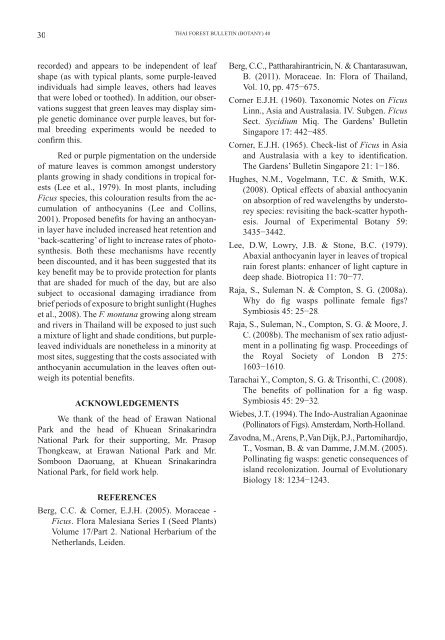Thai Forest Bulletin
Thai Forest Bulletin
Thai Forest Bulletin
You also want an ePaper? Increase the reach of your titles
YUMPU automatically turns print PDFs into web optimized ePapers that Google loves.
30<br />
recorded) and appears to be independent of leaf<br />
shape (as with typical plants, some purple-leaved<br />
individuals had simple leaves, others had leaves<br />
that were lobed or toothed). In addition, our observations<br />
suggest that green leaves may display simple<br />
genetic dominance over purple leaves, but formal<br />
breeding experiments would be needed to<br />
confi rm this.<br />
Red or purple pigmentation on the underside<br />
of mature leaves is common amongst understory<br />
plants growing in shady conditions in tropical forests<br />
(Lee et al., 1979). In most plants, including<br />
Ficus species, this colouration results from the accumulation<br />
of anthocyanins (Lee and Collins,<br />
2001). Proposed benefi ts for having an anthocyanin<br />
layer have included increased heat retention and<br />
‘back-scattering’ of light to increase rates of photosynthesis.<br />
Both these mechanisms have recently<br />
been discounted, and it has been suggested that its<br />
key benefi t may be to provide protection for plants<br />
that are shaded for much of the day, but are also<br />
subject to occasional damaging irradiance from<br />
brief periods of exposure to bright sunlight (Hughes<br />
et al., 2008). The F. montana growing along stream<br />
and rivers in <strong>Thai</strong>land will be exposed to just such<br />
a mixture of light and shade conditions, but purpleleaved<br />
individuals are nonetheless in a minority at<br />
most sites, suggesting that the costs associated with<br />
anthocyanin accumulation in the leaves often outweigh<br />
its potential benefi ts.<br />
ACKNOWLEDGEMENTS<br />
We thank of the head of Erawan National<br />
Park and the head of Khuean Srinakarindra<br />
National Park for their supporting, Mr. Prasop<br />
Thongkeaw, at Erawan National Park and Mr.<br />
Somboon Daoruang, at Khuean Srinakarindra<br />
National Park, for fi eld work help.<br />
REFERENCES<br />
Berg, C.C. & Corner, E.J.H. (2005). Moraceae -<br />
Ficus. Flora Malesiana Series I (Seed Plants)<br />
Volume 17/Part 2. National Herbarium of the<br />
Netherlands, Leiden.<br />
THAI FOREST BULLETIN (BOTANY) 40<br />
Berg, C.C., Pattharahirantricin, N. & Chantarasuwan,<br />
B. (2011). Moraceae. In: Flora of <strong>Thai</strong>land,<br />
Vol. 10, pp. 475−675.<br />
Corner E.J.H. (1960). Taxonomic Notes on Ficus<br />
Linn., Asia and Australasia. IV. Subgen. Ficus<br />
Sect. Sycidium Miq. The Gardens’ <strong>Bulletin</strong><br />
Singapore 17: 442−485.<br />
Corner, E.J.H. (1965). Check-list of Ficus in Asia<br />
and Australasia with a key to identifi cation.<br />
The Gardens’ <strong>Bulletin</strong> Singapore 21: 1−186.<br />
Hughes, N.M., Vogelmann, T.C. & Smith, W.K.<br />
(2008). Optical effects of abaxial anthocyanin<br />
on absorption of red wavelengths by understorey<br />
species: revisiting the back-scatter hypothesis.<br />
Journal of Experimental Botany 59:<br />
3435−3442.<br />
Lee, D.W, Lowry, J.B. & Stone, B.C. (1979).<br />
Abaxial anthocyanin layer in leaves of tropical<br />
rain forest plants: enhancer of light capture in<br />
deep shade. Biotropica 11: 70−77.<br />
Raja, S., Suleman N. & Compton, S. G. (2008a).<br />
Why do fi g wasps pollinate female fi gs?<br />
Symbiosis 45: 25−28.<br />
Raja, S., Suleman, N., Compton, S. G. & Moore, J.<br />
C. (2008b). The mechanism of sex ratio adjustment<br />
in a pollinating fi g wasp. Proceedings of<br />
the Royal Society of London B 275:<br />
1603−1610.<br />
Tarachai Y., Compton, S. G. & Trisonthi, C. (2008).<br />
The benefi ts of pollination for a fi g wasp.<br />
Symbiosis 45: 29−32.<br />
Wiebes, J.T. (1994). The Indo-Australian Agaoninae<br />
(Pollinators of Figs). Amsterdam, North-Holland.<br />
Zavodna, M., Arens, P.,Van Dijk, P.J., Partomihardjo,<br />
T., Vosman, B. & van Damme, J.M.M. (2005).<br />
Pollinating fi g wasps: genetic consequences of<br />
island recolonization. Journal of Evolutionary<br />
Biology 18: 1234−1243.
















